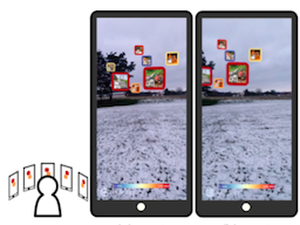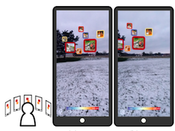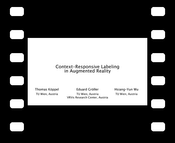Information
- Publication Type: Conference Paper
- Workgroup(s)/Project(s):
- Date: April 2021
- Lecturer: Hsiang-Yun Wu
- Event: IEEE Pacific Visualization Symposium
- DOI: 10.1109/pacificvis52677.2021.00020
- Call for Papers: Call for Paper
- Booktitle: Proceedings of the 14th IEEE Pacific Visualization Symposium
- Pages: 10
- Pages: 1 – 10
Abstract
Route planning and navigation are common tasks that often require additional information on points of interest. Augmented Reality (AR) enables mobile users to utilize text labels, in order to provide a composite view associated with additional information in a real- world environment. Nonetheless, displaying all labels for points of interest on a mobile device will lead to unwanted overlaps between information, and thus a context-responsive strategy to properly ar- range labels is expected. The technique should remove overlaps, show the right level-of-detail, and maintain label coherence. This is necessary as the viewing angle in an AR system may change rapidly due to users’ behaviors. Coherence plays an essential role in retaining user experience and knowledge, as well as avoiding motion sickness. In this paper, we develop an approach that sys- tematically manages label visibility and levels-of-detail, as well as eliminates unexpected incoherent movement. We introduce three label management strategies, including (1) occlusion management, (2) level-of-detail management, and (3) coherence management by balancing the usage of the mobile phone screen. A greedy approach is developed for fast occlusion handling in AR. A level-of-detail scheme is adopted to arrange various types of labels. A 3D scene manipulation is then built to simultaneously suppress the incoherent behaviors induced by viewing angle changes. Finally, we present the feasibility and applicability of our approach through one synthetic and two real-world scenarios, followed by a qualitative user study.Additional Files and Images
Weblinks
BibTeX
@inproceedings{koeppel-2021,
title = "Context-Responsive Labeling in Augmented Reality",
author = "Thomas K\"{o}ppel and Eduard Gr\"{o}ller and Hsiang-Yun Wu",
year = "2021",
abstract = "Route planning and navigation are common tasks that often
require additional information on points of interest.
Augmented Reality (AR) enables mobile users to utilize text
labels, in order to provide a composite view associated with
additional information in a real- world environment.
Nonetheless, displaying all labels for points of interest on
a mobile device will lead to unwanted overlaps between
information, and thus a context-responsive strategy to
properly ar- range labels is expected. The technique should
remove overlaps, show the right level-of-detail, and
maintain label coherence. This is necessary as the viewing
angle in an AR system may change rapidly due to users’
behaviors. Coherence plays an essential role in retaining
user experience and knowledge, as well as avoiding motion
sickness. In this paper, we develop an approach that sys-
tematically manages label visibility and levels-of-detail,
as well as eliminates unexpected incoherent movement. We
introduce three label management strategies, including (1)
occlusion management, (2) level-of-detail management, and
(3) coherence management by balancing the usage of the
mobile phone screen. A greedy approach is developed for fast
occlusion handling in AR. A level-of-detail scheme is
adopted to arrange various types of labels. A 3D scene
manipulation is then built to simultaneously suppress the
incoherent behaviors induced by viewing angle changes.
Finally, we present the feasibility and applicability of our
approach through one synthetic and two real-world scenarios,
followed by a qualitative user study.",
month = apr,
event = "IEEE Pacific Visualization Symposium ",
doi = "10.1109/pacificvis52677.2021.00020",
booktitle = "Proceedings of the 14th IEEE Pacific Visualization Symposium
",
pages = "10",
pages = "1--10",
URL = "https://www.cg.tuwien.ac.at/research/publications/2021/koeppel-2021/",
}


 video
video
